Síndrome de Waardenburg: clasificación clínica de una familia

Resumen
Introducción: El síndrome de Waardenburg (SW) es una entidad infrecuente, hereditaria, que cursa con cierto grado de discapacidad cuando aparece la hipoacusia neurosensorial y su cuadro clínico no está completamente definido.
Objetivo: Describir las características clínicas de una familia afectada con el síndrome y las variantes encontradas.
Material y Método: Estudio de casos, observacional, transversal y descriptivo. Se confeccionó una base de datos automatizada. Las variables utilizadas fueron los signos clínicos, incluyendo la clasificación de la hipoacusia. Se utilizaron medidas de frecuencia: absolutas y relativas porcentuales, y se empleó la prueba de X2 al 95 % de certeza.
Resultados: De los signos clásicos el 100 % mostró distopia cantorum, el resto apareció con variabilidad. Se observaron signos no descritos anteriormente, entre los cuales destacó el dorso nasal recto (65,4 %). Se detectó hallux valgus en 4 de los individuos, lo que permitió clasificar a los individuos en 19 del tipo I, y los 7 restantes en la subvariante 1 del tipo III.
Conclusiones: Las alteraciones óseas encontradas en individuos con SW permiten clasificarlos como portadores de la subvariante III-1, no descrita previamente.
Palabras clave
Referencias
- Tagra S, Talwar AK, Walia RS, Sidhu P. Waardenburg syndrome. Indian J Dermatol Venereol Leprol 2006; 72: 326. En: http://www.ijdvl.com/article.asp?issn=0378-6323;year=2006;volume=72;issue=4;spage=326;epage=326;aulast=. Acceso 20-02-12
-Farrer LA, Grundfest KM, Amos J, Arnos KS, Asher JH, Beighton P, Diehl SR, Fex J, Foy C, Friedman TB. et al. Waardenburg syndrome (WS) type I is caused by defects at multiple loci, one of which is near ALPP on chromosome 2: first report of the WS consortium. Am J Hum Genet. 1992; 50: 902-13. En: http://www.ncbi.nlm.nih.gov/pmc/articles/PMC1682585/pdf/ajhg00076-0021.pdf. Acceso. 26-04-2009
-Tassabehji M, Read AP, Newton VE, Patton M, Gruss P, Harris R, Strachan T. Mutations in the PAX3 gene causing Waardenburg syndrome type 1 and type 2. Nat Genet. 1993; 3: 26-30. En: http://ukpmc.ac.uk/abstract/MED/8490648. Acceso 20-04-2010
-Reynolds JE, Meryer JM, Landa B, Stevens CA, Arnos KS, Israel J, et al. Analysis of variability of clinical manifestations in Waardenburg syndrome. Am J Med Genet. 1995;57:540-7. En: http://onlinelibrary.wiley.com/doi/10.1002/ajmg.1320570405/pdf. Acceso 20-05-2010
-Pardono E, Van Bever Y, Van den Ende J, Havrenne PC, Iughetti P, Maestrelli S, et al. Waardenburg syndrome: clinical differentiation between types I and II. Am J Med Genet. 2003; 117A:223-5. En: http://genoma.ib.usp.br/wordpress/wp-content/uploads/2011/04/2003-pardono-van.bever-
van.den_.ende-havrenne-iughetti-maestrelli-costa-richieri.costa-frota.pessoa-otto.pdf. Acceso: 20-05-2010
-Chandra Deka R. Cochlear implantation in Waardenburg syndrome: The Indian scenario. October 2010, Vol. 130, No. 10, Pages 1097-1100 (doi:10.3109/00016481003713640). En: http://informahealthcare.com/doi/abs/10.3109/00016481003713640. Acceso: 13-12-10
-Gad A, Laurino M, Maravilla K R, Matsushita M, Raskind W H.Sensorineural Deafness, Distinctive Facial Features and Abnormal Cranial Bones a New Variant of Waardenburg Syndrome?. Am J Med Genet A. 2008 July 15; 146A(14): 1880-1885. En: http://onlinelibrary.wiley.com/doi/10.1002/ajmg.a.32402/pdf. Acceso: 13-12-10
-Chen J, Yang SZ, Liu J, Han B, Wang GJ, Zhang X, Kang DY, Dai P, Young WY, Yuan HJ. Mutation screening of MITF gene in patients with Waardenburg syndrome type 2. Yi Chuan. 2008; 30: 433-8. En: http://www.ncbi.nlm.nih.gov/pubmed/18424413. Acceso: 17-02-12
- Huang BY, Zdanski C, Castillo M. Pediatric sensorineural hearing loss, part 2: syndromic and acquired causes. AJNR Am J Neuroradiol[internet]. 2012 Mar[cited 17-02-12];33(3):399-406. Available from: http://www.ajnr.org/content/33/3/399.long
- Lesmas Navarro M J. Cavalle Garrido I. Rodríguez Rivera V. Morera Pérez C. El implante coclear en el síndrome de Waardenburg tipo IV O.R.L. ARAGON 2011; 14(2): 11-13. En: http://dialnet.unirioja.es/servlet/articulo?codigo=3767790&orden=323339&info=link. Acceso: 17-02-12
- Milunsky JM, Maher TA, Ito M, Milunsky A. The Value of MLPA in Waardenburg Syndrome. Genet Test. 2007 Jun;11(2):179-182. http://online.liebertpub.com/doi/pdf/10.1089/gte.2006.0531 acceso: 17-02-12
- Broshtilova V, Ramot Y, Molho- Pessach V, Zlotogorski A: Diabetes mellitus may be the earliest and sole manifestation of the H syndrome. Diabet Med 2009; 26: 1179-1183. En: http://onlinelibrary.wiley.com/doi/10.1111/j.1464-5491.2009.02843.x/pdf. Acceso 20-02-12
- Molho- Pessach V, Lerer I, Abeliovich D, Agha Z, Libdeh AA, Broshtilova V, Elpeleg O, Zlotogorski A: The H syndrome is caused by mutations in the nucleoside transporter hENT3. Am J Hum Genet 2008; 83: 529-534. En: http://www.ncbi.nlm.nih.gov/pmc/articles/PMC2561939/ Acceso: 20-02-12
- Molho- Pessach V, Suarez J, Perrin C, Chiaverini C, Doviner V, Tristan- Clavijo E, Colmenero I, Giuliano F, Torrelo A, Zlotogorski A: The H syndrome: two novel mutations affecting the same amino acid residue of hENT3. J Dermatol Sci 2010; 57:59-61. http://digital.csic.es/handle/10261/38886. Acceso 20-02-12
Copyright (c) 2012 Fidel Castro Pérez, José Guillermo Sanabria Negrín, Reinaldo Menéndez García

Esta obra está bajo una licencia de Creative Commons Reconocimiento-NoComercial-CompartirIgual 4.0 Internacional.







 La revista está: Certificada por el CITMA
La revista está: Certificada por el CITMA